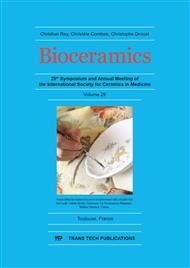[1]
K. Kandori, S. Mizumoto, S. Toshima, M. Fukusumi, Y. Morisada, Effects of Heat Treatment of Calcium Hydroxyapatite Particles on the Protein Adsorption Behavior, J. Phys. Chem. B, 113 (2009) 11016-11022.
DOI: 10.1021/jp904481z
Google Scholar
[2]
Y. Ma, J. Zhanga, S. Guo, J. Shi, W. Du, Z. Wang, L. Ye, W. Gu, Biomimetic mineralization of nano-sized, needle-like hydroxyapatite with ultrahigh capacity for lysozyme adsorption, Mater. Sci. and Eng. C 68 (2016) 551–556.
DOI: 10.1016/j.msec.2016.06.021
Google Scholar
[3]
A. Oyane, T. Ootsuka, K. Hayama, Y. Sogo, A. Ito, Enhanced immobilization of acidic proteins in the apatite layer via electrostatic interactions in a supersaturated calcium phosphate solution, Acta Biomaterialia 7 (2011) 2969–2976.
DOI: 10.1016/j.actbio.2011.04.012
Google Scholar
[4]
M. Matsumoto, T. Miyake, H. Noshi, M. Kambara, K. Konishi, Zeta Potential Studies on the Adsorption of Proteins on a Synthetic Hydroxyapatite, Coll. And Surf. 40 (1989) 77-84.
DOI: 10.1016/0166-6622(89)80008-3
Google Scholar
[5]
T. Kokubo, H. Kushitani, S. Sakka, T. Kitsugi, T. Yamamuro, Solutions able to reproduce in vivo surface-structure changes in bioactive glass-ceramic A-W., J. Biomed. Mater. Res. 24 (1990) 721-734.
DOI: 10.1002/jbm.820240607
Google Scholar
[6]
T. Kokubo, H. Takadama, How useful is SBF in predicting in vivo bone bioactivity?, Biomaterials 27 (2006) 2907-2915.
DOI: 10.1016/j.biomaterials.2006.01.017
Google Scholar
[7]
H. Takadama, T. Kokubo, In vitro evaluation of bone bioactivity, in: T. Kokubo (Ed. ), Bioceramics and their clinical applications, Woodhead Publishing, Cambridge, 2008, pp.165-182.
DOI: 10.1533/9781845694227.1.165
Google Scholar
[8]
T. Yao, M. Hibino, S. Yamaguchi H. Okada, Japanese Patent 5261712 (2013), U.S. Patent 8178066 (2012).
Google Scholar
[9]
T. Yabutsuka, S. Tsuboi, M. Hibino, T. Yao, Fabrication of Encapsulated Ag Microsphere with Hydroxyapatite for Sustained-Release, Key Eng Mater. 361-363 (2008) 1199-1202.
DOI: 10.4028/www.scientific.net/kem.361-363.1199
Google Scholar
[10]
S. Yamane, T. Yabustuka, M. Hibino, T. Yao, Fabrication of encapsulated silicagel microsphere with hydroxyapatite for sustained-release, Key Eng Mater. 396-398 (2009) 519-522.
DOI: 10.4028/www.scientific.net/kem.396-398.519
Google Scholar
[11]
T. Matsunaga, T. Yabutsuka, S. Takai, T. Yao, Fabrication of Hydroxyapatite Microcapsules for Controlled Release of Hydrophobic Drug, Key Eng Mater. 720 (2017) 12-16.
DOI: 10.4028/www.scientific.net/kem.720.12
Google Scholar
[12]
T. Yabutsuka, T. Yao, Fabrication of encapsulated magnetite microparticles with hydroxyapatite, Energy Procedia 9 (2011) 532-538.
Google Scholar
[13]
S. Kumazawa, D. Hisashuku, T. Yabutsuka, T. Yao, Fabrication of Magnetic Hydroxyapatite Microcapsule for Protein Collection, Key Eng. Mater. 587 (2014) 160-164.
DOI: 10.4028/www.scientific.net/kem.587.160
Google Scholar
[14]
T. Yabutsuka, S. Kumazawa, D. Hisashuku, H. Mizutani, K. Fukushima, S. Takai, T. Yao, Enzyme Immobilization by Using Apatite Microcapsules with Magnetic Properties, Key Eng. Mater, 696 (2016) 259-264.
DOI: 10.4028/www.scientific.net/kem.696.259
Google Scholar
[15]
M. Bradford, A Rapid and Sensitive Method for the Quantitation of Microgram Quantities of Protein Utilizing the Principle of Protein-Dye Binding, Anal. Biochem. 72 (1976) 248-254.
DOI: 10.1016/0003-2697(76)90527-3
Google Scholar


